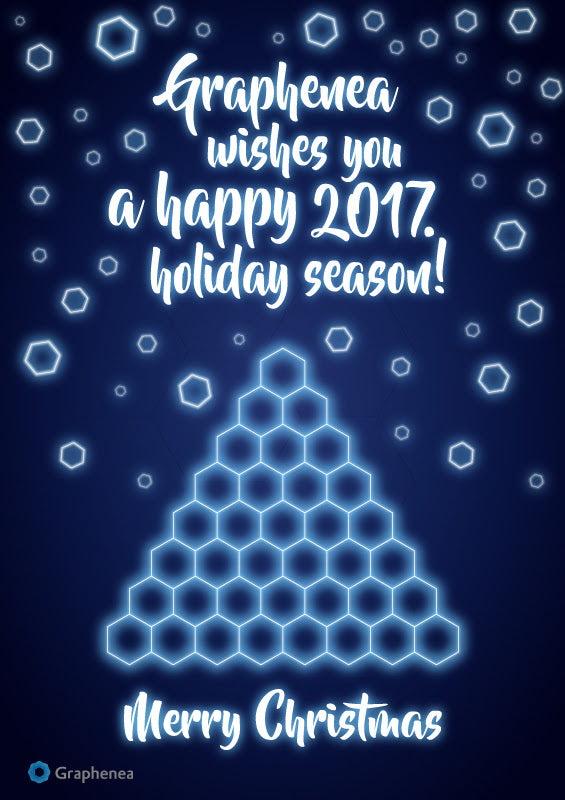Graphene – from science to business in 2016
2016 was another successful year for Graphenea, both scientifically and in business.
Our research team participated in some of the most important scientific results of the year that found their place in top scientific publications. We continued our lasting collaboration with researchers at CIC nanoGune and ICFO in Spain to image in unprecedented detail plasmons in graphene. Plasmons are optical waves confined to the surface of a material that have potential applications in computing technology, sensing, and quantum communication. Plasmons in graphene are more interesting than in conventional metal materials, in that they can be easily controlled and tuned with electric gating. Our paper in Nature Photonics resolved the intricate details of edge and sheet plasmons in graphene nano-resonators.
As described in our second most impactful publication of the year, our collaborators from Delft University of Technology made an optical system to make precise automated measurements of the deflection of graphene membranes. Graphene membranes hold potential for many applications such as gas impermeable membranes, MEMS and NEMS pressure sensors, water filtration, high sensitivity ultrasonic speakers and microphones, quantum memories, and for fundamental scientific studies of opto- and nano-mechanics, thus their reliable large-scale characterization is an imperative task.
Graphene photonics is an extremely relevant line of research, as can be judged by another publication in Nature Communications that used Graphenea’s graphene. Scientists from Switzerland used layers of our CVD graphene in a stack with polymer layers to produce a non-reciprocal optical isolator operating at THz frequencies. Terahertz communication circuits would boast wireless transmission rates 10 times faster than they are today and this new isolator that transmits light only one way could form an important component of those circuits. For all three of these optical applications, it was important to use high quality graphene from our CVD line.
In collaboration with researchers from the UK, our team revealed important details of the workings of graphene sensors. Careful study showed that graphene gas sensors are strongly affected by both ambient humidity and the substrate on which graphene is placed. In case of bilayer graphene, the bottom layer is strongly affected by the substrate, while the top is almost entirely dominated by ambient conditions. This important work showed that graphene sensors need to be carefully calibrated and other graphene devices must be encapsulated with protective layers. The work was published in the renowned journal Carbon.
Also published in Carbon in 2016 is our study on the effect of wrinkles on CVD graphene. These wrinkles naturally form during the growth process, but our work together with researchers from Serbia shows that frictional damage to graphene always starts at the wrinkles, which turn out to be the material’s weakest point. Furthermore, the wrinkles act as tiny barriers that impede the flow of current through graphene, affecting its overall electrical performance. This careful study of electrical and mechanical effects of wrinkles in graphene is expected to lead to new experiments on improving graphene uniformity and flatness, helping to speed up the adoption of graphene technology.
Finally, as a hint of what we can expect from graphene technology in the coming years, Graphenea’s Business Director Iñigo Charola has been championing the use of graphene in next-gen lithium sulfur batteries. Graphene oxide is expected to play a prominent role in these future batteries that will quadruple the specific energy stored compared to lithium ion batteries used today. Graphenea engaged in new research projects for hybrid graphene-quantum dot infrared photodetectors for food safety, the use of graphene in next-gen medicine, and capture of greenhouse gases.
From a business perspective, we could have hardly wished a more successful year. We strengthened our Scientific Advisory Board with prof. Jeehwan Kim of MIT at the start of the year. Soon after that, our scientific research team was significantly enhanced with the joining of Dr. Amaya Ortega and Dr. Oihana Txoperena. Enhancing material quality and scientific collaboration remain key pillars of our business strategy.
Our CVD graphene production capacity increased with the addition of a new 8” growth system in April. The system is housed in our new cleanroom, where we expect production to start at the beginning of 2017. In September we introduced a new product: Easy Transfer. Easy Transfer makes creating graphene samples on custom substrates a breeze for our customers, since it features graphene that is already detached from the CVD growth substrate. We also made life easier for our customers that make use of graphene oxide by introducing dry graphene oxide (GO) powder to our catalog. Compared to GO suspended in liquid, dry GO is easier to dispense in a composite matrix, eliminating extra chemistry steps in production.
Meanwhile our pilot plant for production of 1 tpa of graphene oxide is under construction according to plan, set to start working at the end of 2017.
We are proud that our efforts of integrating graphene in CMOS fabrication was recognized by SEMI with our entry to the list of finalists for the “Best of West” award.
Hoping for another successful year together with our loyal customers and followers, aiming for new graphene research and application breakthroughs, team Graphenea wishes you all the best in 2017!

